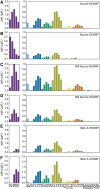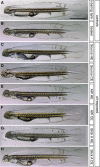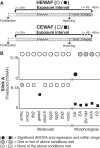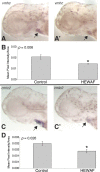Corresponding morphological and molecular indicators of crude oil toxicity to the developing hearts of mahi mahi
- PMID: 26658479
- PMCID: PMC4674699
- DOI: 10.1038/srep17326
Corresponding morphological and molecular indicators of crude oil toxicity to the developing hearts of mahi mahi
Abstract
Crude oils from distinct geological sources worldwide are toxic to developing fish hearts. When oil spills occur in fish spawning habitats, natural resource injury assessments often rely on conventional morphometric analyses of heart form and function. The extent to which visible indicators correspond to molecular markers for cardiovascular stress is unknown for pelagic predators from the Gulf of Mexico. Here we exposed mahi (Coryphaena hippurus) embryos to field-collected crude oil samples from the 2010 Deepwater Horizon disaster. We compared visible heart defects (edema, abnormal looping, reduced contractility) to changes in expression of cardiac-specific genes that are diagnostic of heart failure in humans or associated with loss-of-function zebrafish cardiac mutants. Mahi exposed to crude oil during embryogenesis displayed typical symptoms of cardiogenic syndrome as larvae. Contractility, looping, and circulatory defects were evident, but larval mahi did not exhibit downstream craniofacial and body axis abnormalities. A gradation of oil exposures yielded concentration-responsive changes in morphometric and molecular responses, with relative sensitivity being influenced by age. Our findings suggest that 1) morphometric analyses of cardiac function are more sensitive to proximal effects of crude oil-derived chemicals on the developing heart, and 2) molecular indicators reveal a longer-term adverse shift in cardiogenesis trajectory.
Figures







References
-
- Adams J. et al. Identification of compounds in heavy fuel oil that are chronically toxic to rainbow trout embryos by effects-driven chemical fractionation. Environ Toxicol Chem 33, 825–835 (2014). - PubMed
-
- Bornstein J. M. et al. Effects-driven chemical fractionation of heavy fuel oil to isolate compounds toxic to trout embryos. Environ. Toxicol. Chem. 33, 814–824 (2014). - PubMed
-
- Incardona J. P., Collier T. K. & Scholz N. L. Defects in cardiac function precede morphological abnormalities in fish embryos exposed to polycyclic aromatic hydrocarbons. Toxicol. Appl. Pharmacol. 196, 191–205 (2004). - PubMed
-
- Brette F. et al. Crude oil impairs cardiac excitation-contraction coupling in fish. Science 343, 772–776 (2013). - PubMed
Publication types
MeSH terms
Substances
LinkOut - more resources
Full Text Sources
Other Literature Sources
Medical

